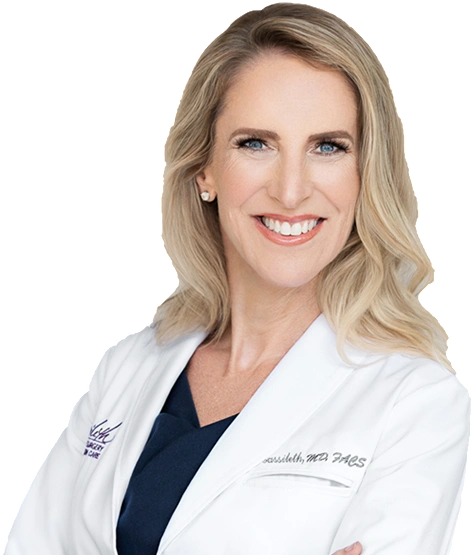
Breast Reconstruction
Inventor of Direct-to-Implant Breast Reconstruction in Los Angeles
A breast cancer diagnosis is a traumatic event that often marks the beginning of a long road of medical care. Many women who undergo mastectomy as part of their breast cancer treatment can find comfort and empowerment in breast reconstruction. Direct-to-implant breast reconstruction, also known as immediate breast reconstruction or single-stage reconstruction, is an advanced technique that allows women to wake up from their mastectomy surgery with natural-looking results, with no need for tissue expanders or additional surgeries.
Dr. Lisa Cassileth pioneered the one-stage breast reconstruction. This single-stage reconstructive surgery has lower risks compared to traditional tissue expander reconstruction, as shown in Dr. Cassileth’s original publication in 2012 in the Annals of Plastic Surgery. Traditional reconstructive methods that utilize tissue expanders can be uncomfortable and require prolonged surgical care. By placing a breast implant above the pectoralis major muscle and performing a nerve graft, our plastic surgeons avoid injuring the chest wall and preserve sensation. This makes the reconstruction process shorter and more comfortable, and no further surgical procedures are required.
Board-Certified Beverly Hills Plastic Surgeon, Breast Specialist, and Direct-to-Implant Breast Reconstruction Inventor
Women have come to us and expressed frustration with the traditional delayed reconstruction process. Some women who have already had reconstruction surgery are unhappy with their results. The truth is that the traditional plastic and reconstructive surgery process can be painful, requires multiple surgeries, and gives less-than-ideal outcomes. The traditional, standard goal of breast reconstruction has been to make you “look normal in clothes.” With Direct-to-Implant breast reconstruction, we are changing the “standard of care” for breast reconstruction. Our standard is “naked in the locker room” – you should feel comfortable and sexy with your new, reconstructed breasts, and confident that no one in the locker room will even be able to tell that you had breast cancer surgery.
Double-Board-Certified Beverly Hills Plastic Surgeon and Breast & Body Specialist
Contact Cassileth Plastic Surgery about capsular contracture in Los Angeles, Beverly Hills, Santa Monica, and beyond.
The first step is a consultation appointment with one of our caring and experienced breast reconstruction surgeons. We will discuss your medical history and your goals and perform an exam to determine if this type of procedure is right for you. Our team will review any specific pre-surgery instructions with you.
Every patient is unique and your surgical plan will depend on your individual anatomy and aesthetic goals. In general, we begin reconstruction immediately after the oncological breast surgeon completes the mastectomy. We create an internal bra using dermal matrix to hold the implants in place and give you a beautiful and natural-looking result. Next we will reconnect the deep nerves to the superficial nerves to preserve breast sensation.
At Cassileth Plastic Surgery, we go above and beyond to provide breast reconstruction patients with the highest level of post-surgical care. We provide nerve-blocking injections to minimize any post-surgical pain in the days after surgery. Our concierge nurse staff will provide detailed post-operative instructions and be available to help you heal and recuperate after your procedure.
We perform direct-to-implant, above-the-muscle reconstruction on almost every one of our mastectomy patients, with extremely low risk of complications and highly aesthetic results. So, what do we do differently than everyone else? There are a few important distinctions: the choice of the mastectomy surgeon; specific techniques designed to blend and support the implant; and a set of surgical and perioperative protocols that further increase the comfort and safety of the surgery.
In any mastectomy with reconstruction, two surgeons are involved: the breast surgeon (who does your mastectomy) and the plastic surgeon (who does your breast reconstruction after the mastectomy is complete). Obviously, having a great plastic surgeon is important to having a great result, but having an excellent mastectomy surgeon is equally critical. As plastic surgeons, we can only give you the best aesthetic outcome when you have the best mastectomy surgeon. We only work with breast surgeons who have demonstrated an extremely low risk of mastectomy flap necrosis, an unfortunately common condition that can cause death of the breast skin. Our favorite surgeons are at BedfordBreastCenter.com, and have a mastectomy flap necrosis risk as low as 1%, when most surgeons have a rate of 30% or higher. Our breast cancer surgeons use nipple-sparing mastectomy and skin-sparing mastectomy techniques. These experienced surgeons use only a small incision at the crease under the breast—a feat that other surgeons find too technically difficult, but that we know can improve your surgical outcome.
Next, we employ specific implant placement techniques to achieve natural-looking results. When it comes to the breast reconstruction portion of the procedure, the details make all the difference. First, the pectoral muscle is left intact, which means the recovery is far less painful, and avoids an unnatural-looking condition called “pec flex” deformity, where the pectoral muscle moves the breast upon flexing. Second, we create an internal bra. Most plastic surgeons wrap the implant with acellular dermal matrix and place it in the mastectomy flap, which lets the implant droop to the bottom of the breast pocket and gives the implant very little support. We create a full internal bra prior to placing the implant, using dermal matrix to bridge the gap between the implant and the chest wall.
This softens the contour of the implant, makes it look more natural, gives it room to shift slightly as a natural breast does, and decreases the need for fat grafting later. Third, we now offer the option to reinnervate breast skin. During mastectomy surgery, the nerves which naturally pass through the breast tissue are removed, leaving the breast numb. Using an allogenic nerve graft, we can reconnect the deep nerves to the superficial nerves, which allows for breast sensation. This is performed at the same time as the reconstruction, but the nerve must regrow through the graft. Sensation improves as you heal.
Finally, we pay attention to a few key surgical and perioperative details that further increase the comfort and safety of surgery. We use a Prevena VAC to seal the closure under a sterile, mild vacuum for five days after surgery. This radically lowers the risk of surgical infection and improves oxygenation of the wound edge, lowering complications rates. Next, we perform Exparel nerve-blocking injections during surgery, which blocks pain for three days after surgery. This decreased pain helps encourage early mobility after surgery (getting moving helps you recover faster!). Our concierge nurse staff will follow you closely after surgery, which allows us to attend fully to your needs from day to day.
Browse our gallery to see the results of our breast reconstruction surgeries.
Surgical techniques have continued to improve, and we can now create a breast that often looks as good as, or better than the original. However, mastectomy typically leaves the breast and nipple numb. We are thrilled to now offer our patients a nerve graft at the time of the mastectomy surgery and finally give patients an option to restore some sensation.
The nerves that are cut during mastectomy are meticulously and carefully reconnected to nerve endings in the skin. Patients typically start to notice sensation returning as early as three months after the mastectomy.
Sensation-preserving mastectomies are good options for women who want to preserve sensation and are undergoing mastectomy. The nerves that are used are toward the outside of the breast, where the lateral intercostal nerves traditionally enter the breast tissue. The proximal nerve must be away from any area that may contain DCIS or breast cancer. Breast implant size may need to be limited depending on the individual patient’s anatomy.
Traditional mastectomy usually causes the loss of sensation to the breast and nipple, more importantly light touch, which is protective, as well as pleasure sensation. That is because traditional mastectomy resects the nerves that supply sensation to the majority of the breast skin and nipple. The cut nerves can even cause painful sensations or rarely, neuromas. With sensation-preserving mastectomy, a few months after surgery sensation will start to improve. The sensation will spread over the top of the breast until it has fully reinnervated, which may take up to one year.
Sensation-preserving mastectomy is best performed by a team of surgeons specializing in their unique skills. Three aspects of the operation are critical to successful outcome: first, the mastectomy must preserve normal subcutaneous fat, and avoid complications such as skin necrosis. We only trust our surgeons, Dr. Leslie Memsic and Dr. Heather Richardson, to perform the mastectomy, as they carefully avoid injury to the main intercostal nerves and the skin containing the nerve endings. The breast reconstruction, performed by our plastic surgeons, Dr. Kelly Killeen and Dr. Lisa Cassileth, must be performed over the muscle and ideally direct-to implant. The third critical factor is that our surgeons work together to dissect the nerve prior to the mastectomy, and then reconnect the nerve endings after the reconstruction. The final stage of the operation is a microsurgical procedure and involves advanced training with nerve grafting. We are the first team to offer this operation in Southern California, and we see patients from throughout the US.
We often hear from our patients that other surgeons have told them “you aren’t a candidate for direct-to-implant reconstruction.” They are told that it is too dangerous, and it only works for non-droopy, A- and B-sized breasts. Having performed hundreds of direct-to-implant reconstructions over more than 15 years, we are here to tell you that it’s not true. First, consider that it’s actually the first part of the surgery, the mastectomy, that is typically higher risk. For most breast cancer surgeons, the complication rate due to mastectomy flap necrosis is 30% or more.3 That means that most plastic surgeons are very wary of trying direct-to-implant reconstruction because they fear that the skin or nipple may die after the surgery. This would mean that the skin would need removal and closure. So they advise their patients to have a three-phase surgical process, with mastectomy and placement of tissue expanders, followed by three months of painful expansion, followed by surgery to replace the expanders with permanent implants. With our mastectomy surgeons, the risk of mastectomy flap necrosis is very low, around 1%. This means we can trust the breast skin, nipple, and areola to survive.
We prefer to save patients from the unnecessary use of tissue expanders, which we believe are outdated. With a pre-pectoral implant that easily fits in place of the breast tissue, a tissue expander is not needed.
Direct-to-implant can be used in combination with other techniques where appropriate. For women with large or droopy breasts, we place the implant using an "autoderm flap" which lifts and protects at the same time; this is where extra skin is used to reinforce the implant position and a breast lift is done concomitantly to the mastectomy.
For patients who have undergone radiation therapy of the breasts, it is much safer to perform the reconstruction over the muscle, and also use the direct to implant techniques to minimize the increased risk of infection that comes with multiple implant surgeries. For patients with existing breast augmentation, the implants are usually placed under the muscle since the muscle is already partially detached from the chest wall.
We proudly offer Aesthetic Flat Closure, a specialized technique focused on achieving a smooth chest appearance after mastectomy, without the need for additional surgeries, implants, or a second surgical donor site.
Referred to as "going flat," Aesthetic Flat Closure involves a meticulous rearrangement of tissues to restore a natural contour to the chest. When mastectomy is performed without reconstructive procedures, the chest can sometimes exhibit a concave appearance, leading to distress and a decrease in self-confidence. Our highly skilled surgeons are experts in tissue rearrangement techniques, enabling them to address this concern and provide patients with an aesthetically pleasing flat chest outcome.
We also offer a revolutionary no-implant one-stage surgery called the SWIM breast reconstruction, which is an enhanced and refined version of the Goldilocks technique, incorporating advancements in surgical approaches and precision for optimal breast reconstruction outcomes. Like our direct-to-implant reconstruction, the SWIM breast reconstruction is carried out at the same time as a mastectomy, but involves creating a breast from the patient's own existing tissue and fat instead of using an implant. Our article, published in the Journal of the American College of Surgeons, details the procedure and proves the many benefits of this approach.4 The SWIM is ideal for larger-breasted women who want natural-looking, smaller breasts, as well as those who have undergone radiation treatments for cancer or who have multiple risk factors and health issues.
The Cassileth Plastic Surgery team performs more than 400 reconstruction cases each year. This includes Direct-to-Implant breast reconstruction, nipple reconstruction, reconstruction revisions, SWIM flaps, and fat grafting. Most of those cases are one-stage procedures—primary breast reconstructions done at the same time as the patient's mastectomy—in our Beverly Hills surgery center.
We are dedicated to helping women live with confidence and comfort. During your consultation appointment, we will discuss your medical history and your aesthetic goals and answer any questions you have. If you are not an ideal candidate for single-stage reconstruction with saline or silicone implants, we will guide you to a procedure that is right for your needs and goals.
1Cassileth L, Kohanzadeh S, Amersi F. One-stage immediate breast reconstruction with implants: a new option for immediate reconstruction. Ann Plast Surg. 2012 Aug;69(2):134-8. doi: 10.1097/SAP.0b013e3182250c60. PMID: 21734545.
2Breastcancer.org Satisfaction with breast reconstruction results. Available: https://www.breastcancer.org/treatment/surgery/reconstruction
3Robertson SA, Jeevaratnam JA, Agrawal A, Cutress RI. Mastectomy skin flap necrosis: challenges and solutions. Breast Cancer (Dove Med Press). 2017;9:141-152. Published 2017 Mar 13. doi:10.2147/BCTT.S81712
4 Cassileth LB, Killeen KL, Richardson HH. SWIM Flap: Skin-Sparing, Wise Pattern, Internal Mammary Perforator Breast Reconstruction. J Am Coll Surg. 2020 May;230(5):e21-e26. doi: 10.1016/j.jamcollsurg.2019.12.015. Epub 2020 Jan 17. PMID: 31958499.

Dr. Kelly Killeen is not just an outstanding surgeon and artist, she is also an angel. I had 15+ surgeries to correct an ongoing problem for last 10 years, numerous super-famous doctors worked on me, in different parts of the world, including Geneva, Berlin, etc.. So by the time I got into Dr. Kelly's hands the words "total mess" don't even begin to describe the actual condition of what used to be my breasts. Dr. Killeen, just as regular angel performed a miracle and made everything good again. I love you. There is also nurse Dee who is just incredible human being, here level of compassion, love and care is truly rare. Last but not the list there is a Brit called Jade - she is so beautiful, funny and totally awesome, I will find a reason to come again for some facial peeling or something else simple just to see you guys! I am so blessed to have met these beautiful people, they maybe just part of exceptional medical team, but in my heart they will always be my friends...
Arrange a consultation for capsular contracture treatment at Beverly Hills' Cassileth Plastic Surgery. Women from Santa Monica, the entire Los Angeles area, and beyond can Send a message online or call (310) -278-8200.
Connect with us on social media! We pride ourselves on building real relationships with our patients near and far.

